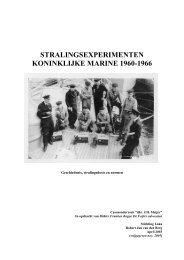CHERNOBYL; CHRONOLOGY OF A DISASTER - Antenna
CHERNOBYL; CHRONOLOGY OF A DISASTER - Antenna
CHERNOBYL; CHRONOLOGY OF A DISASTER - Antenna
Create successful ePaper yourself
Turn your PDF publications into a flip-book with our unique Google optimized e-Paper software.
25 April (Friday)<br />
13.05 hours (local time): Preparations for the turbine test<br />
begin. For this test, the plant's capacity must be reduced and<br />
for this reason one turbine is turned off.<br />
Times-zones<br />
Local times: At the time of the 1986 accident, Ukraine<br />
was one of the Republics of the USSR (Union of Socialist<br />
Soviet Republics) and had Moscow-time (GMT+3).<br />
Although Ukraine changed its time to GMT+2 after it<br />
declared independence from Moscow in August 1991,<br />
times mentioned in the Chronology are historical local<br />
times (GMT+3). Times mentioned concerning Sweden's<br />
Forsmark, are also GMT+3. Time difference (in 1986)<br />
between Chernobyl and Sweden was 2 hours.<br />
14.00 hours: The controller of the Ukraine electricity network<br />
requests that the test be delayed. All electricity from Unit 4 is<br />
necessary. It is not clear why it was not predictable beforehand<br />
that work would have to continue all through Friday<br />
afternoon in order to achieve the production planned for April.<br />
16.00 hours: The day shift leaves. The members of this shift<br />
have been given information about the test during the previous<br />
days, and know about the entire procedure. A special<br />
team of electronic engineers is present.<br />
23.10 hours: Preparations for the test start again. The ten<br />
hour delay has a large number of consequences. Firstly, the<br />
team of engineers is tired. Secondly, during the test, the evening<br />
shift is replaced by the night shift. This shift has fewer<br />
experienced operators, besides which they were not prepared<br />
for the test. Achier Razachkov, - Yuri Tregub and A. Uskov are<br />
the operators who were responsible for carrying out the test<br />
earlier in the day: later in interviews they declared that test<br />
procedures were only explained to the day and evening shifts.<br />
Yuri Tregub decides to stay and help the night shift.<br />
26 April (Saturday)<br />
01.00 hours: During preparations for the test, the operators<br />
have difficulty keeping the capacity of the nuclear plant stable.<br />
While doing this they make six important mistakes.<br />
1. The control rods which can stop the reactor are raised higher<br />
than regulations permit. Operator Uskov of the day shift<br />
said later that he would have done the same. He said: "We often<br />
don't see the need to follow the instructions to the letter,<br />
because rules are often infringed all around us." As well as<br />
this, he pointed to the fact that during training it was repeated<br />
over and over again that "a nuclear power plant cannot explode".<br />
Operator Kazachkov said: "We have often had fewer<br />
control rods than were required, and nothing ever happened.<br />
No explosion, everything just went on as normal."<br />
2. The plant's capacity decreases to below the safe level.<br />
Because of this the core becomes unstable. Preparations for<br />
the test should have been stopped by now. It should have<br />
been obvious that all attention should be given to measures<br />
for regaining the plant's stability.<br />
3. In order to raise the capacity, an extra circulation pump is<br />
turned on. Because of the strong cooling down, the pressure<br />
falls, thus reducing the reactor's capacity rather than increasing<br />
it. Normally at this stage the scram system should start<br />
working, but in order to still be able to carry out the test, this<br />
system is turned off.<br />
4. The automatic emergency shut-down system is turned off<br />
in order to prevent the reactor stopping itself.<br />
5. The systems to prevent the' water level decreasing too<br />
much and the temperature of the fuel elements becoming too<br />
high are also turned off.<br />
6. Finally, the emergency cooling system is turned off to prevent<br />
it working during the test.<br />
1.23.04 hours: The real test now begins. The power plant's<br />
capacity suddenly increases unexpectedly.<br />
1.23.40 hours: Leonid Toptunov, responsible for the control<br />
rods, presses a special button for an emergency shutdown.<br />
The test has been going on for 36 seconds.<br />
1.23.44 hours: The control rods start to descend, but shocks<br />
can be felt. The operators see that the control rods have become<br />
stuck. The fuel tubes have become deformed because<br />
of the large increase in the steam pressure.<br />
1.24.00 hours: The test has now been going on for 56<br />
seconds. Pressure in the reactor is now so high that the fuel<br />
elements burst and small particles land in the cooling water.<br />
The cooling water turns into steam and pressure in the tubes<br />
increases: they burst.<br />
The 1000 ton lid above the fuel elements is lifted: the first<br />
explosion. The release of radiation starts. Air gets into the<br />
reactor. There is enough oxygen to start a graphite fire. The<br />
metal of the fuel tubes reacts to the water. This is a chemical<br />
reaction which produces hydrogen, and this hydrogen explodes:<br />
the second explosion. Burning debris flies into the air<br />
and lands on the roof of Chernobyl Unit 3. (There was barely<br />
any attention paid to this hydrogen explosion in the Soviet<br />
report about the accident. In studies commissioned by the<br />
US government, however, it was concluded that the second<br />
explosion was of great significance, and that the original explanation<br />
of the accident was incorrect. Richard Wilson of the<br />
Harvard University in the US said this second explosion was a<br />
small nuclear explosion.)<br />
The head of the night shift, Alexander Akinhov, and the engineer<br />
responsible for industrial management, Anatoly Diatlov,<br />
do not believe that an accident has taken place. When somebody<br />
claims the core has exploded, they send out operators<br />
to examine the core. These people are killed by radiation. On<br />
hearing the report that the reactor has been destroyed Akimov<br />
cries out, "The reactor is OK, we have no problems."<br />
Akimov and Diatlov, assisted by manager Bryukhanov and<br />
engineer N.Fomin, keep ordering the operators to add more<br />
cooling water. They remain convinced that there is nothing<br />
wrong. Akimov and Toptunov, who was responsible for the<br />
control rods, both died of radiation illness. Diatlov and Fomin<br />
were both sentenced to ten years imprisonment for infringement<br />
of the safety regulations. However, at the end of 1990<br />
they were both released.<br />
2- THE ACCIDENT AND IMMEDIATE CONSEQUENCES<br />
Unit 4 of the Nuclear power plant at Chernobyl explodes.<br />
Debris flies into the air and lands on the roof of Unit 3 which is<br />
right next to the exploded Unit 4. The units share a communal<br />
machine turbine hall with a roof of bitumen, a flammable material.<br />
Thirty fires develop. The fact that the accident happens<br />
at night has one great advantage: in the daytime, 2000 people<br />
are working on the construction of Chernobyl Units 5 and 6.<br />
These people are now at home.<br />
01.25 hours: The fire alarm rings at the local fire station.<br />
Meanwhile more people are killed: The nuclear plant's fire<br />
fighters arrive with three fire engines. The leader, Lieutenant<br />
Pravik, quickly realizes that his team is too small and asks<br />
the fire brigades from Pripyat, the town of Chernobyl and the<br />
entire area of Kiev for their assistance. Pravik and his team<br />
climb onto the roof of the machine hail and start their attempts<br />
to extinguish the fire. The fire brigade, from Pripyat ar-<br />
4<br />
Nuclear Monitor 724


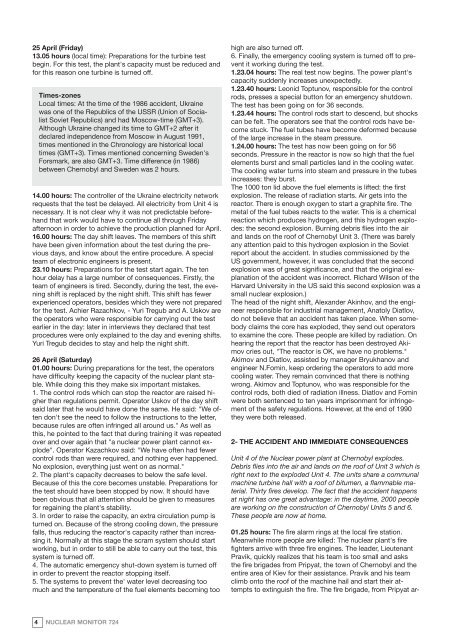
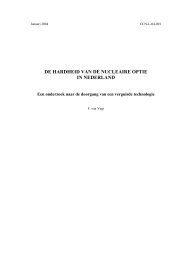


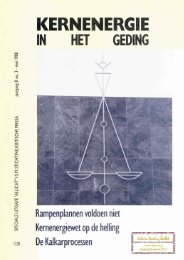
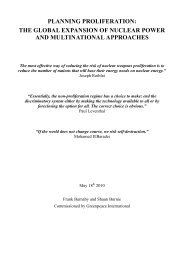


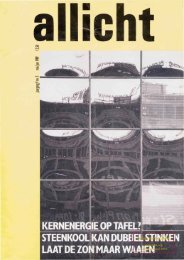
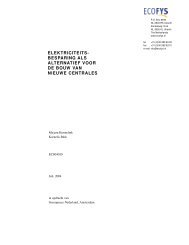

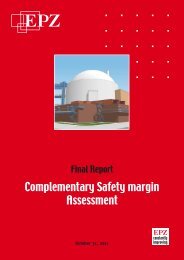

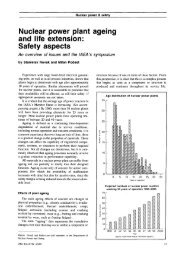
![EPZ jaarverslag 2009 [PDF] - Laka.org](https://img.yumpu.com/40394048/1/190x190/epz-jaarverslag-2009-pdf-lakaorg.jpg?quality=85)
